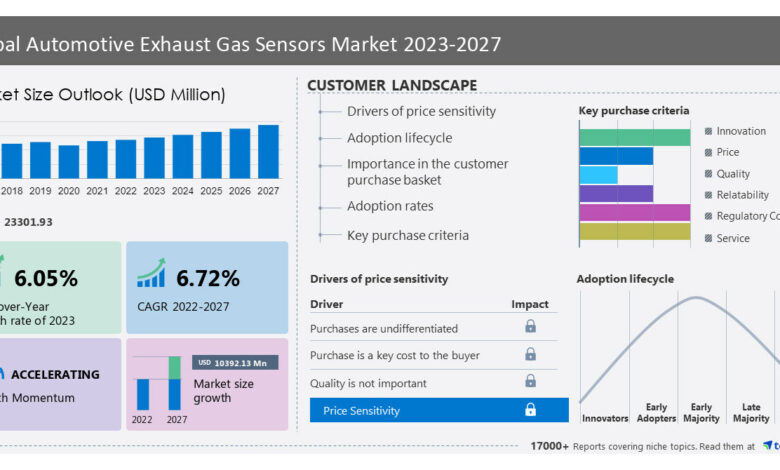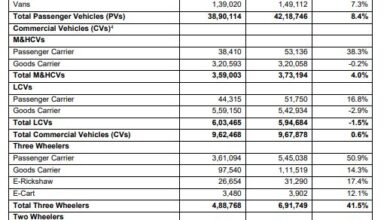Automotive Exhaust Gas Sensors Market size is set to grow by USD 10.39 billion from 2023-2027, increase in demand for automobiles boost the market, Technavio

NEW YORK, April 19, 2024 /PRNewswire/ — The global automotive exhaust gas sensors market size is estimated to grow by USD 10392.13 mn from 2023-2027, according to Technavio. The market is estimated to grow at a CAGR of over 6.72% during the forecast period. Automotive exhaust gas sensors are integral to reducing environmental and health concerns from vehicle emissions. With economic expansion in countries like India, Russia, and Brazil, the demand for these sensors grows in tandem with automotive production. Manufacturing disruptions can impact sensor control units, necessitating ruggedness and quick reaction time. Self-driving cars and automotive automation require advanced sensors, including radar, LiDAR, and image sensors, for accuracy and reliability. OEMs comply with norms and regulations through exhaust gas sensors, addressing temperature, gases, and fuel emissions.
For more insights on the historic (2017 – 2021) and forecast market size– Request a sample report
|
Automotive Exhaust Gas Sensors Market Scope |
|
|
Report Coverage |
Details |
|
Base year |
2022 |
|
Historic period |
2017 – 2021 |
|
Forecast period |
2023-2027 |
|
Growth momentum & CAGR |
Accelerate at a CAGR of 6.72% |
|
Market growth 2023-2027 |
USD 10392.13 million |
|
Market structure |
Fragmented |
|
YoY growth 2022-2023 (%) |
6.05 |
|
Regional analysis |
APAC, Europe, North America, South America, and Middle East and Africa |
|
Performing market contribution |
APAC at 72% |
|
Key countries |
US, China, Japan, India, and Germany |
|
Key companies profiled |
ABB Ltd., Analog Devices Inc., Broadcom Inc., Continental AG, Delphi Technologies Plc, DENSO Corp., Emerson Electric Co., Faurecia, HELLA GmbH and Co. KGaA, Hitachi Ltd., Honeywell International Inc., Hyundai Motor Co., Infineon Technologies AG, MS Motorservice International GmbH, NGK SPARK PLUG Co. Ltd., Robert Bosch GmbH, Sensata Technologies Inc, Stoneridge Inc., Tenneco Inc., and Tohoku Shibaura Electronics Co. Ltd. |
Segment Overview
This automotive exhaust gas sensors market report extensively covers market segmentation by Type (Oxygen sensor, Temperature sensor, NOx sensor, Particulate matter sensor, Differential pressure sensor) End-user (Passenger vehicles, Commercial vehicles) Geography (APAC, Europe, North America, South America, Middle East and Africa)
Market Segmentation by Type
The Automotive Exhaust Gas Sensors Market experiences significant growth due to economic expansion in developing countries, driving automotive production. Manufacturing disruptions and production halts are potential challenges, necessitating sensor control units with quick reaction time and communication capability. Ruggedness is crucial for sensors in various vehicle types, including automotive, medium commercial, and heavy commercial vehicles. Technology providers, semiconductor vendors, and smart mobility firms collaborate to develop advanced sensors using microfabrication technology. Reaction time, communication capability, and accuracy are essential factors for sensors in self-driving cars and automotive automation. Automotive companies face increasing pressure to meet norms and regulations regarding vehicular emissions, fuel emissions, and temperature. Exhaust gas sensors play a vital role in engine control units, preventing overheating and ensuring vehicular component reliability. Tragic events emphasize the importance of sensor technology in reducing human involvement in vehicular accidents. Advanced sensors, such as radar, LiDAR, and image sensors, contribute to the development of autonomous vehicles using AI and machine learning technology. Gases monitored by exhaust gas sensors include CO, HC, NOx, and O2. Ensuring accuracy and reliability is crucial for maintaining emission levels and adhering to regulatory standards.
Geography Overview
The Automotive Exhaust Gas Sensors Market in APAC is experiencing significant growth, driven by economic expansion and increasing consumer disposable income in China and India. This market is crucial for automotive manufacturing, with sensor control units playing a pivotal role in ensuring vehicular emissions compliance. However, manufacturing disruptions and production halts can impact sensor production and supply. Advanced technologies like microfabrication, reaction time, communication capability, ruggedness, and AI are integral to sensor design. Self-driving cars and automotive sensors are key areas of automobile automation, with technology providers, semiconductor vendors, and smart mobility firms collaborating on microchips, fusion devices, and machine learning technology. Ensuring accuracy and reliability in exhaust gas sensors is essential for meeting norms and regulations, particularly in medium and heavy commercial vehicles. Tragic events underscore the importance of human involvement in overseeing OEMs’ adherence to emission levels, as they produce gases like CO2, NOx, and SO2. Radar, LiDAR, and image sensors are vital for monitoring engine control units and preventing overheating. Despite challenges, the future of automotive sensors lies in the integration of advanced technologies and the development of autonomous vehicles.
Insights on the market contribution of various segments including country and region wise, historic (2017 – 2021) and forecast market size– Download a Sample Report
- The automotive exhaust gas sensors market involves sensors collaborating with ECMs to monitor harmful emissions. ECMs, as central computing units, collect data for maintaining vehicle function. Advanced sensors integrate with cloud systems for support functions like online repair services, predictive maintenance, and improved driving tracking. Manufacturing disruptions impact production of sensor control units, affecting economic expansion and automotive production. Microfabrication technology enhances ruggedness and reaction time. Self-driving cars rely on AI, machine learning, and sensors like radar, LiDAR, and image sensors for accuracy and reliability. OEMs comply with norms and regulations regarding vehicular fuel emissions and temperature.
- The automotive industry faces rising emission norms, driving OEMs to innovate exhaust systems and engine technologies. Precious metal sensors for NOx, O2, and exhaust pressure are essential. Electric vehicles also utilize exhaust sensors. Exhaust gas sensors include O2, MAP/MAF, temperature, pressure, and particulate matter sensors. These sensors contribute to vehicle efficiency, safety, and comfort, while addressing pollution concerns and CAFÉ standards. The market for automotive exhaust gas sensors is growing due to increasing demand for electronics in the automotive industry.
Insights on Market Drivers, trends, & Challenges, historic period(2017 – 2021) and forecast period(2023-2027)- Request a sample report!
Research Analysis
The Automotive Exhaust Gas Sensors Market plays a crucial role in the monitoring and regulation of vehicular emissions, ensuring compliance with norms and regulations. These sensors, including temperature sensors, NOx sensors, and engine coolant sensors, are integral vehicular components that contribute to both efficiency and pollution control. By detecting physical properties such as fluid level, pressure, and exhaust gas temperature, these sensors enable the engine control unit to optimize engine performance and minimize exhaust emissions. The market for automotive exhaust gas sensors is significant, encompassing applications in passenger cars, commercial vehicles, and automobiles of all types. The transition towards electric vehicles is expected to influence market growth, as these vehicles also require exhaust sensors for battery management systems. Overall, the market for automotive exhaust gas sensors is essential for addressing the environmental concerns of vehicular overheating and greenhouse effects, while maintaining safety, comfort, and efficiency.
Market Research Overview
The Automotive Exhaust Gas Sensors market is experiencing significant growth due to the increasing demand for stringent emission regulations and the rising awareness of environmental concerns. These sensors play a crucial role in monitoring the exhaust gases from vehicles, enabling the reduction of harmful pollutants. The market is driven by the continuous advancements in technology, leading to the development of more accurate and efficient sensors. The market is segmented based on vehicle type, technology, and region. Europe and North America are major markets due to the strict emission norms in these regions. The Asia Pacific region is expected to witness robust growth due to the increasing vehicle production and the growing awareness of environmental issues. The future of the Automotive Exhaust Gas Sensors market looks promising with the ongoing research and development in the field of sensor technology.
About Technavio
Technavio is a leading global technology research and advisory company. Their research and analysis focuses on emerging market trends and provides actionable insights to help businesses identify market opportunities and develop effective strategies to optimize their market positions.
With over 500 specialized analysts, Technavio’s report library consists of more than 17,000 reports and counting, covering 800 technologies, spanning across 50 countries. Their client base consists of enterprises of all sizes, including more than 100 Fortune 500 companies. This growing client base relies on Technavio’s comprehensive coverage, extensive research, and actionable market insights to identify opportunities in existing and potential markets and assess their competitive positions within changing market scenarios.
Contacts
Technavio Research
Jesse Maida
Media & Marketing Executive
US: +1 844 364 1100
UK: +44 203 893 3200
Email: [email protected]
Website: www.technavio.com/
SOURCE Technavio



